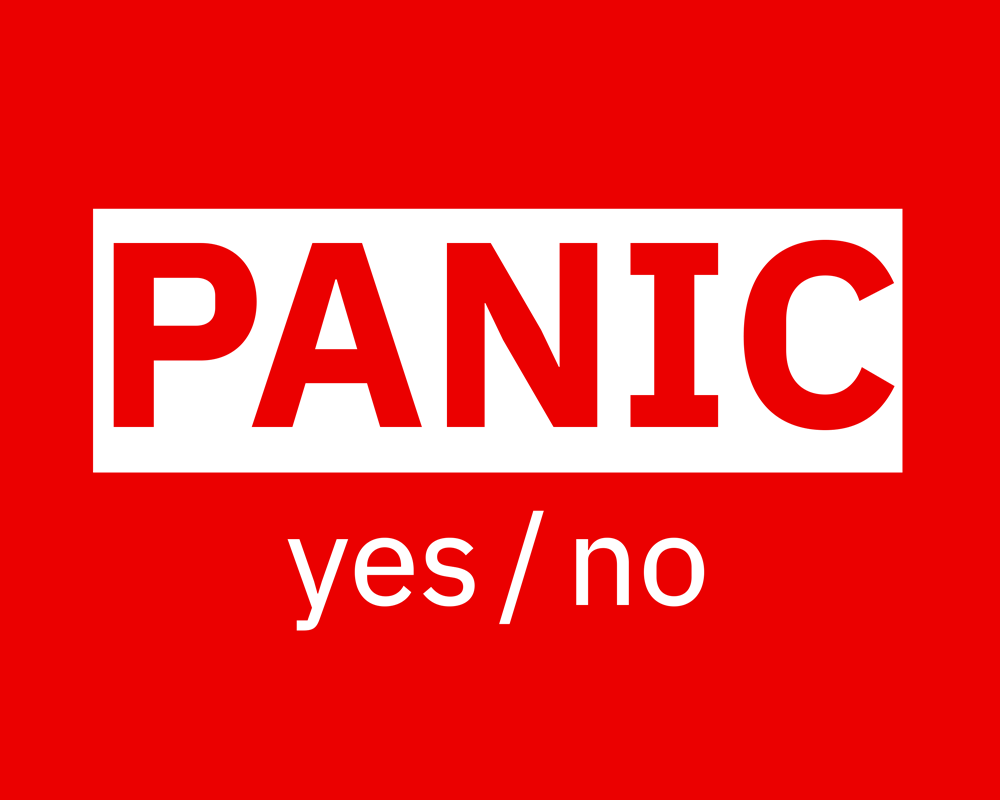

3.–7.
Sept.
POSTCITY
Linz
PANIC – yes/no
Panic, yes or no? Shouldn’t we have long been in a state of absolute panic by now? Why aren’t we? There seem to be countless reasons for panic. Or is it all just scaremongering? How long can hope last, and what will follow it?
Ars Electronica 2025
- A festival exploring the status quo of our time, a time full of contradictions and uncertainty.
- A festival about artistic work and impact in this time of profound upheaval.
- A festival for art, technology, and society at the beginning of the second quarter of the 21st century.
When we no longer understand the world around us, when things change faster than we can comprehend them, we humans apparently tend to become irrational, paying more attention to how loud a voice is than to what it is actually saying, and preferring to believe what we want to hear as truth. We find ourselves back in Plato’s cave, worshipping the shadow interpreters.
Nothing seems more disturbing than change; yet we need nothing more urgently than change. But we are increasingly unable to agree on what or who should change and how it should be accomplished.
…and what do we even mean when we talk about radical changes?
Come gather ’round people
Wherever you roam
And admit that the waters
Around you have grown
And accept it that soon
You’ll be drenched to the bone
If your time to you is worth savin’
And you better start swimmin’
Or you’ll sink like a stone
For the times they are a-changin’
When Bob Dylan wrote these lines in 1963, which are so relevant to our times, not least in view of the fact that water levels are now literally rising, the civil rights movement in the USA had reached a peak—the March on Washington and Martin Luther King’s “I have a dream” have become iconic in history—and it was clear to everyone what kind of upheaval was being talked about: new beginnings, progress, freedom, coded as ideals of the Western world, seemed so irresistibly convincing and unstoppable that it would only be a matter of time before they would prevail globally.
It was also the time in which the USA was finally able to position itself as the global hegemonic power—militarily, economically, and perhaps above all culturally, “The American Way of Life” prevailed in the free world. Politically, John F. Kennedy’s “Ich bin ein Berliner” (I am a Berliner), just a few months before he was assassinated, became the legendary symbol of a hegemonic understanding of a protective sovereign who does not subjugate, but rather motivates voluntary allegiance through the advantages and promises of his lifestyle. At least, that is how it was understood, since elsewhere people were not squeamish about using military might and nuclear deterrence as tools of power. (The 20-year Vietnam War, 1955–1975, was not fought in order to conquer the country, but rather to assert the claim to leadership.)
All that was missing was the collapse of the USSR after the fall of the Berlin Wall in 1989, and the deal seemed to be sealed. However, it had been overlooked that the economic interdependencies and dependencies resulting from globalization and the far-reaching liberalization of markets—coupled with the global digital infrastructure—would also bring about a decentralization of power structures. Not a dissolution, but a fragmentation in which power is no longer exercised exclusively through direct control or hierarchical structures, but increasingly depends on consensus building and the balancing of interests.
In the resulting hegemonic interregnum, not only did emerging geopolitical actors, especially China, position themselves, but there was also a massive shift toward technology corporations, which, with their own feudal spheres of power, evade state regulation in many areas. While the United States remains the central nervous system of global financial markets, this symbol of power has also experienced visible signs of erosion due to the dynamics of globalization and, most recently, the rise of cryptocurrencies.
Panic does not arise from the mere fear of danger, but from the realization of its inevitability—the feeling of being defenselessly exposed to it, with no possibility of escape or control.
Against this backdrop, the irrational (because it’s not based on facts and reality-based strategies) turn to oligarchic fascist ideologies, as we currently see in the USA, can certainly be seen as a panic reaction of a global power that has to face the fact that it has lost, or is about to lose, its hegemony. Frustration over the “American Decline” is accordingly one of the strongest motivations behind the MAGA narrative. Trying to explain the broad support solely with dissatisfaction over high egg prices falls short and overlooks the deeper psychology behind it.
The aggressively erratic behavior of Trump, his followers, and agitators—these castles in the air of rage and self-importance—in their force and doggedness bear clear traits of a final rebellion, a defiant denial of reality. We know how dangerous and destructive these symptoms of agony are, not only from many historical examples—it is also currently evident in Vladimir Putin’s belligerent restoration efforts and the broad approval his policies enjoy in Russia.
Of course, the same can be said about Europe’s new right-wing extremism, where the only new thing is its worryingly increased reach and the dull insensitivity with which we face these excesses.
In an unprecedentedly interconnected and digitally borderless world, people are suddenly seeking territorial boundaries and confines again; the problems of migration flows are only part of the reason for this. The sudden resurgence of interest in land ownership and physical territory, reflected in the rhetoric of those leaving the EU as well as in Trump’s fantasies of annexing Greenland and Canada, is a reaction to the loss of control that one faces in internationally and globally networked alliances. Those who cannot assert themselves in the expanse of negotiation and consensus-building would rather return to the small table and pound on it with their fists.
What we should be afraid of.
What’s brewing is a fear-driven mood, ranging from vague rejection to abysmal hatred, directed against anything that smacks of change. Against immigration, against climate activists, against diversity, against transgender people, against the realization that the world is far more complex than we’d like it to be.
Common sense is declared to have primacy over science and knowledge, and truth is no longer defined as the agreement of a statement with its subject matter, but rather as the lowest common denominator of claims that most closely correspond to what we wish for rather than what is actually happening. Regardless of the fact that 2024 was the hottest year on record, regardless of the fact that the coronavirus vaccination has saved countless people from severe illness, from long-term COVID, and even from death… etc. etc.
This erosion of truth, driven by the profit-driven algorithms of social media, is followed by the erosion of trust, perhaps the most important element for the cohesion of a society.
What is turning fear into panic, even more than the unpredictability and recklessness of the Trump administration, is the emerging disorientation now that Trump has renounced loyalty and solidarity—cornerstones of the hegemonic order since the end of World War II 80 years ago—within the entire free world (including within the United States). A disorientation as a result of which Europe is now committing itself, at breathtaking speed, to a war economy and arming itself with weapons that will be largely useless in the truly decisive battle of the coming decades: the fight against the effects of climate change.
When fear can no longer be attributed to specific dangers and risks, it turns into panic; the stress hormone adrenaline is released, the heart rate accelerates, more blood is pumped through the veins, and the muscles tense.
Do we react recklessly or do we concentrate our strength?
Fear makes us small and discouraged. How can we maintain and strengthen our momentum for the future?
How do we avoid getting stuck in the fear of uncertainty and forgetting that we can only move forward through constant change? By insisting on the status quo, we rob ourselves of the power of imagination and the courage to see the future as a viable prospect that we must shape.
And that is precisely the task of artistic work and its impact in this time of profound upheaval.

The Times They Are a-Changin‘
From the uncertainty of the present to the power of art – in conversation with Gerfried Stocker, we shed light on the theme of the Ars Electronica Festival 2025.
Gerfried Stocker,
Co-CEO / Artistic Director Ars Electronica
Gerfried Stocker (AT) is a media artist and an engineer for communication technology and has been artistic director and co-CEO of Ars Electronica since 1995. In 1995/96 he developed the exhibition strategies of the Ars Electronica Center with a small team of artists and technicians and was responsible for the setup and establishment of Ars Electronica’s own R & D facility, the Ars Electronica Futurelab. He has overseen the development of the program for international Ars Electronica exhibitions since 2004, the planning and the revamping of the contents for the Ars Electronica Center, which was enlarged in 2009, since 2005; the expansion of the Ars Electronica Festival since 2015; and the extensive overhaul of Ars Electronica Center’s contents and interior design in 2019. Stocker is a consultant for numerous companies and institutions in the field of creativity and innovation management and is active as a guest lecturer at international conferences and universities. In 2019 he was awarded an honorary doctorate from Aalto University, Finland.
